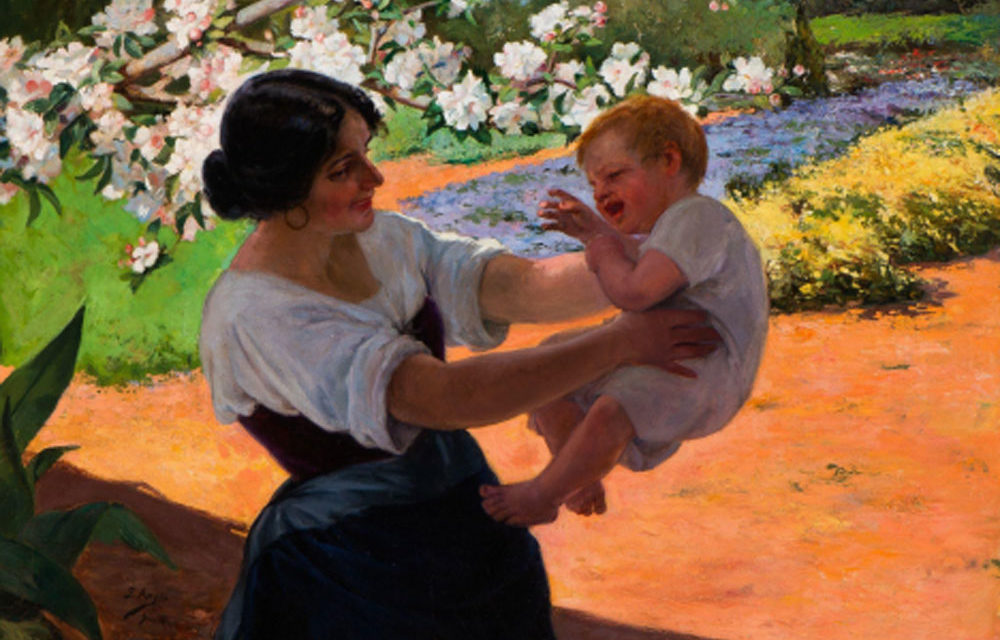The San Antonio Museum of Art opened the exhibit America’s Impressionism: Echoes of a Revolution June 12, and the inclusion of a large painting by Latino artist Jose Arpa, [En el Jardin] who painted in San Antonio during the years 1899-1930, pleased me greatly. I was familiar with a few American Impressionists– John Singer Sargent, Mary Cassatt, Julian Onderdonk, and Clide Hassan. Now I can add a fifth–Arpa.
I first became familiar with Jose Arpa twenty years ago when I walked into the San Antonio Express News Building on Houston Street and saw the entire upper walls covered with beautiful mural panels. Curious, I asked about the paintings and discovered that the mural had been completed in 1930 by a Latino artist, Jose Arpa, who lived in San Antonio on and off from 1899 to 1931.
Jose Arpa [1859-1952] was a young, but very talented Spanish artist when his country sent four of his paintings to the World’s Columbian Exposition in Chicago in 1893. His participation in this Exposition opened the door for Arpa to relocate to Mexico in 1895. Over the next twenty years, especially after relocating to Texas, Arpa established himself as one of America’s best known Latino artists.
Although Arpa’s paintings are in dozens of museums in Spain, Mexico, and the United States, his story is not well known. Arpa was born in 1858 in Carmona, a small town in Andalusia, Spain. His father, a clobber, recognized his son’s artistic talents and arranged for an apprenticeship to a painter and decorator in Seville. By his mid teens, Arpa was enrolled in the School of Fine Arts in Seville where he received three successive scholarships to study in Rome.
Arpa’s life took a new direction when he decided to leave Spain in 1895 for a post as an art instructor in Mexico City. Shortly after the Chicago Exposition, Mexican government cultural officials invited Arpa to teach at the famed Academy of San Carlos in Mexico City. Although Arpa came to Mexico City, he never accepted the job. While in Mexico City, he encountered two Spanish artists he had studied with in Seville. The artists invited Arpa to join them in Puebla. They established a strong friendship, and his friends included Arpa in all family affairs. When his friend’s children prepared to leave for private schooling in San Antonio, Texas, Arpa committed to traveling with them as a chaperone.
Arpa made his living as a painter and art teacher in San Antonio, but also spent time in Mexico and Spain. While in San Antonio he established friendships with the leading artists of the city. The San Antonio Light reported on October 23, 1899 that “Prof. Jose Arpa, a talented artist now in the city, has painted a splendid portrait of Master Paul Lovelace, a cash boy for Joske Bros., which is now in exhibition in Joske’s display window.”*
Photographer Ernest Raba was one of the first in San Antonio to discover the art of Jose Arpa. Perhaps seeing the work of Arpa at the Joske department store, Raba inquired about him and soon met him. Raba came to San Antonio in 1891 from Bohemia. Several years later he established an Art Club which included famed Texas artists Robert and Robert Julian Onderdonk, as well as author O’Henry. Raba invited his new friend Arpa to all their social gatherings.
In 1900 Arpa entered his painting, “Funeral Mexicano” [Entierro en Jalapa] at the International Fair of San Antonio. The painting was bought by the Boston Museum for $12,000, making Arpa’s painting perhaps the first Latino art to be acquired by a major American museum. With the funds to acquire a studio and purchase art supplies, Arpa selected San Antonio as his U.S. residence. With a new studio space downtown, Arpa explored the surrounding rural areas of San Antonio for his plein air landscape paintings.
Various sources note that Arpa’s studio was adjacent to Raba’s studio in the Clifford Building, a one of a kind exquisite structure facing the San Antonio River on Commerce Street.* An early account of the Raba and Arpa friendship, that I found at the Witte Museum library, noted that “Mr. Raba’s attractive studio now houses sixty-six of Mr. Arpa’s splendid paintings.”
By the 1920s, many of Arpa’s works were sold in Europe, Mexico, and Argentina. In an essay, “A History of Texas Artists and Sculptors,” published in the late 1920s, the authors noted that Arpa was well represented in Central Europe’s National Galleries where he was referred to as “The Brilliant Spanish Colorist.” The essay mentioned above referred to Arpa as a “versatile and facile painter, doing portraits, landscapes, and still life with equal ease.” *
In the early 1920s Arpa invited his talented nephew Xavier Gonzales to join him in San Antonio. Gonzales had studied at the San Carlos Academy of Mexico City and continued his studies with his uncle. Gonzalez also earned recognition as one, if not the first, Latino to graduate from the prestigious Art Institute of Chicago.
Arpa and his nephew Gonzales shared a home and studio and opened their own art school near Brackenridge Park. In 1930 Arpa received a life pension from the Spanish government and decided to move back to his birthplace in Spain. He passed away at age 90, but his many artistic contributions live on in the Americas.
*Witte Museum, San Antonio, Texas. Vertical files.
(Photo Captions: José Arpa y Perea, Spanish, active Spain, Mexico, and the United States, 1860-1952, In the Garden (En el jardin), ca. 1931, Oil on canvas, h. 52 3/4 in, w. 59 1/2 in. San Antonio Museum of Art. Photography by Peggy Tenison; Jose Arpa “Picking Cotton.” Courtesy of The San Antonio Art League. This painting won a $2,000 first prize for Arpa in 1928; Jose Arpa, “Rural Scene in Texas.” Courtesy of the Witte Museum. San Antonio, Texas.)
Jose Arpa: America’s First Latino Impressionist









